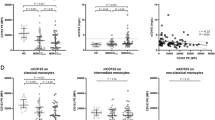Abstract
The production of oxygen metabolites is probably important in cancer cell killing. The production of the superoxide anion, O2 −, can be measured by lucigenin-enhanced chemiluminescence (Cl). Previous studies have shown that whole-blood lucigenin-enhanced Cl is increased in cancer patients and that this increase is related to blood monocyte activity. The present investigation confirmed these findings and showed that whole-blood lucigenin-enhanced Cl was elevated in 17 patients with renal cell adenocarcinoma (P<0.001). The activity of the monocytes was studied more in detail, whereby monocytes were separated into different populations based upon differences in densities, i.e., high-density and low-density monocytes. The cancer patients had a significantly larger proportion of high-density monocytes (P<0.05) than controls. The lucigenin-enhanced Cl of purified high-density monocytes in controls was significantly higher than that of low-density monocytes (P<0.01). The authors conclude that the increase in the lucigenin-enhanced Cl of whole blood observed in cancer patients may partly reflect the increased activity of a larger proportion of high-density monocytes in these patients.
Similar content being viewed by others
References
Nathan, C. F., H. W. Murray, andZ. A. Cohn. 1980. Current concepts: The macrophage as an effector cell.N. Engl. J. Med. 303(11):622–626.
Johnston, R. B. 1988. Current concepts: Immunology, monocytes and macrophages.N. Engl. J. Med. 318(12):747–752.
Dolph, O. A., andT. A. Hamilton. 1988. Phagocytic cells: Cytotoxic activity of macrophages.In Inflammation. Basic Principals and Clinical Correlates. J. I. Gallin, I. M. Goldstein, and R. Snyderman, editors. Raven Press, New York. 471–492.
Klebanoff, S. J. 1988. Phagocytic cells: Products of oxygen metabolism.In Inflammation. Basic Principals and Clinical Correlates. J. I. Gallin, I. M. Goldstein, and R. Snyderman, editors. Raven Press, New York. 391–444.
Cameron, D. J., andW. H. Churchill. 1979. Cytotoxicity of human macrophages for tumor cells.J. Clin. Invest. 63:977–984.
van Furth, R. 1988. Phagocytic cells: Development and distribution of mononuclear phagocytes in normal steady state and inflammation.In Inflammation. Basic Principles and Clinical Correlates. J. I. Gallin, I. M. Goldstein, and R. Snyderman, editors. Raven Press, New York. 281–295.
Allen, R. C., R. L. Stjernholm, andR. H. Steele. 1972. Evidence for the generation of an electronic exitation state(s) in human polymorphonuclear leukocytes and its participation in bacterial activity.Biochem. Biophys. Res. Commun. 47:679–684.
Elias, J., T. J. Ferro, M. D. Rossman, J. A. Greenberg, R. P. Daniela, A. D. Schreiber, andB. Freundlich. 1987. Differential prostaglandin production by unfractionated and density-fractionated human monocytes and alveolar macrophages.J. Leukocyte Biol. 42:114–121.
Cameron, D. J. 1984. Separation of macrophages on discontinuous bovine serum albumin (BSA) density gradients: Cytotoxic effects of fractionated cells from normal donors and cancer patients.Int. J. Immunopharmacol. 6(6):601–607.
Weiner, R. S., andR. R. Mason. 1984. Subfraction of human blood monocyte subsets with percoll.Exp. Hematol. 12:800–804.
Bloom, E. T., andJ. T. Babbitt. 1990. Prostaglandin E2, monocyte adherence and interleukin-1 in the regulation of human natural killer cell activity by monocytes.Nat. Immun. Cell. Growth Regul. 9:36–48.
Spear, G. T., R. J. June, andA. L. Landay. 1989. Oxidative burst capability of human monocyte subsets defined by high and low HLA-DR expression.Immunol. Invest. 18(8):993–1005.
Trulson, A., S. Nilsson, andP. Venge. 1989. Lucigenin-enhanced chemiluminescence in blood is increased in cancer.Am. J. Clin. Pathol. 91(4):441–445.
Vadas, M. A., N. Nicola, F. Lopez, D. Metcalf, G. Johnson, andA. Pereira. 1984. Mononuclear cell-mediated enhancement of granulocyte function in man.J. Immunol. 133(1):202–207.
Mullink, H., M. von Blomberg, M. M. Wilders, H. A. Drexhage, andC. L. Alons. 1979. A simple cytochemical method for distinguishing EAC rosettes formed by lymphocytes and monocytes.J. Immunol. Methods 29:133–137.
Tono-Oka, T., N. Ueno, T. Matsumoto, M. Ohkawa, andS. Matsumoto. 1983. Chemiluminescence of whole blood 1. A simple and rapid method for estimation of phagocytic function of granulocytes and opsonic activity in whole blood.Clin. Immunol. Immunopathol. 26:66–75.
Graves, D. T., Y. L. Jiang, M. J. Williamson, andA. J. Valente. 1989. Identification of monocyte chemotactic activity produced by malignant cells.Science 245:1490–1493.
Turpin, J., E. M. Hersh, andG. Lopez-Berenstein. 1986. Characterization of small and large human peripheral blood monocytes: Effects of in vitro maturation on hydrogen peroxide release and on the response to macrophage activators.J. Immunol. 136(11):4194–4197.
Ysaka, T., N. M. Mantich, L. A. Boxer, andR. L. Baehner. 1981. Functions of human monocyte and lymphocyte subsets obtained by countercurrent centrifugal elutriation: Differing functional capacities of human monocyte subsets.J. Immunol. 127(4):1515–1518.
Hoover, D. L., andM. S. Meltzer. 1989. Lymfokines as monocyte activators.In Human Monocytes. M. Zembala and G. L. Asherton, editors. Academic Press, New York 151–160.
Author information
Authors and Affiliations
Additional information
This study was supported by grants from the Medical Research Council of the Medical Faculty of Uppsala University and the Swedish Cancer Society.
Rights and permissions
About this article
Cite this article
Trulson, A., Nilsson, S., Brekkan, E. et al. Patients with renal cancer have a larger proportion of high-density blood monocytes with increased lucigenin-enhanced chemiluminescence. Inflammation 18, 99–105 (1994). https://doi.org/10.1007/BF01534602
Issue Date:
DOI: https://doi.org/10.1007/BF01534602




